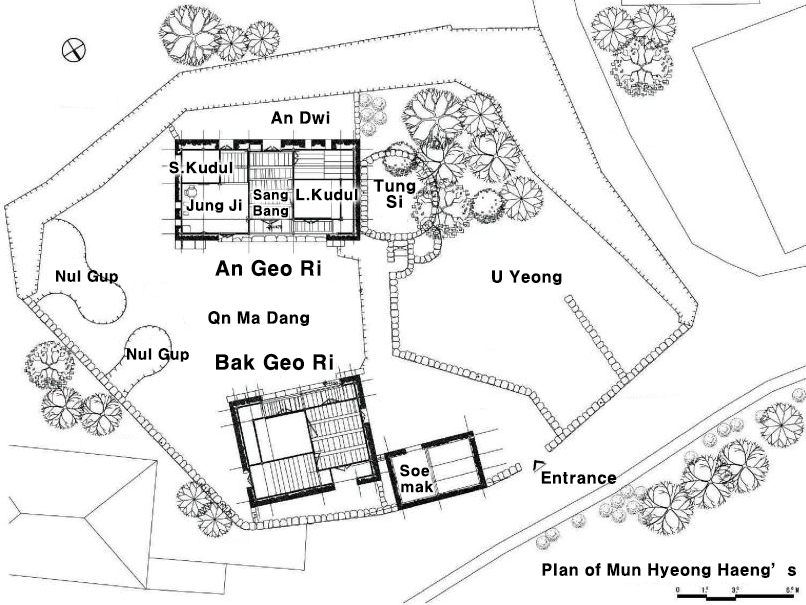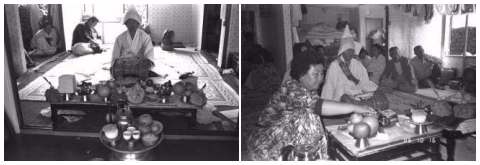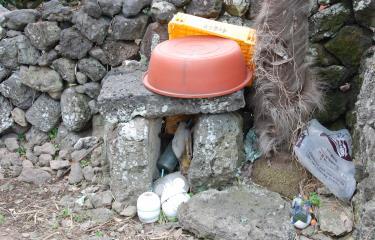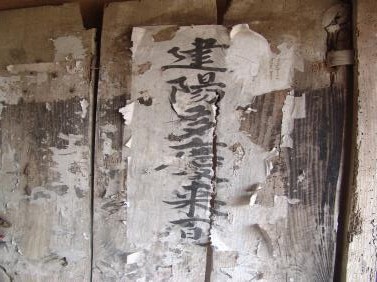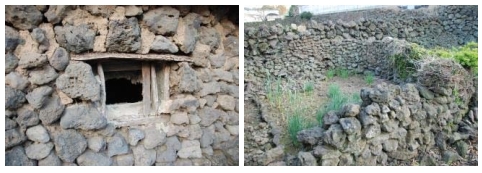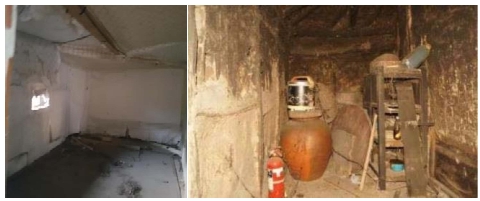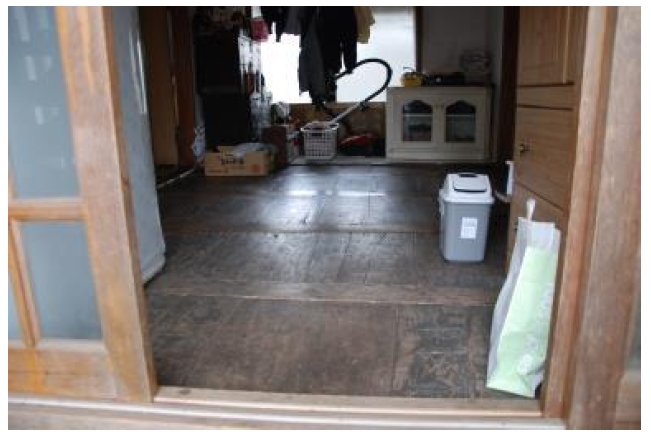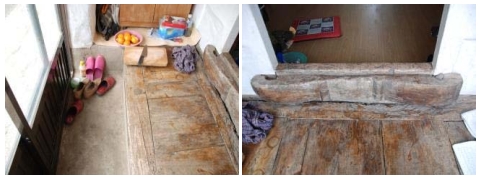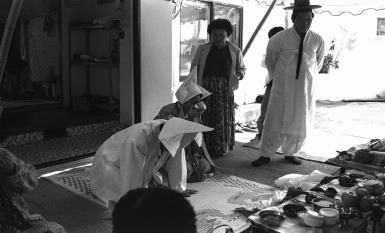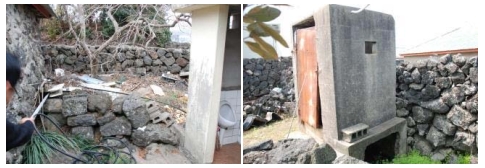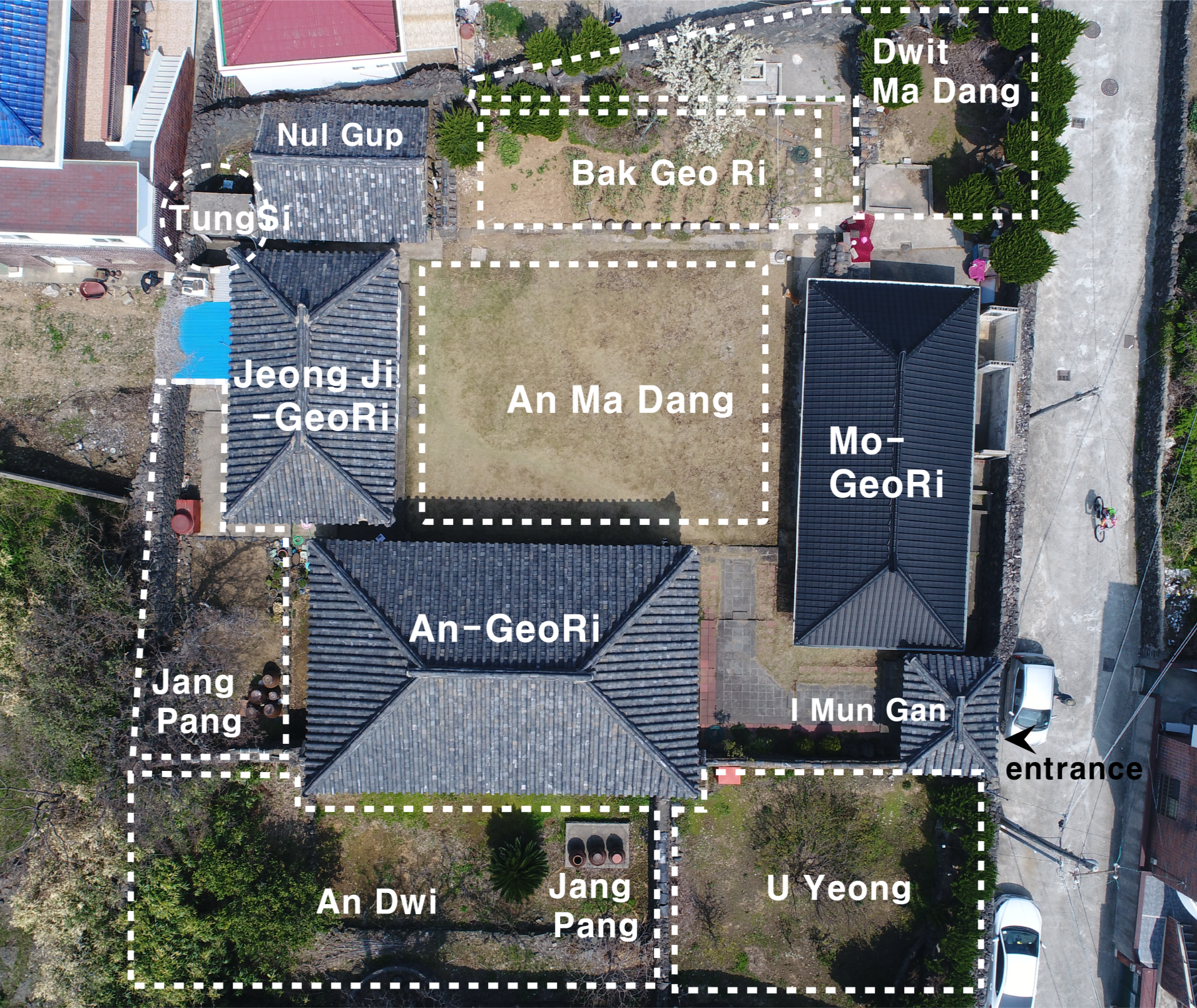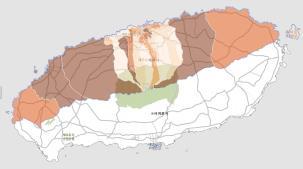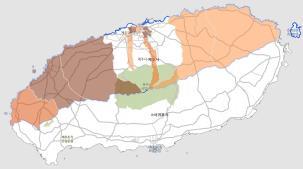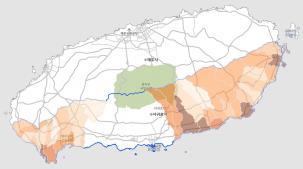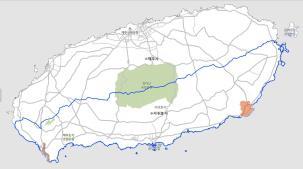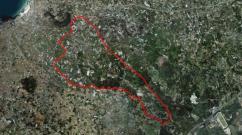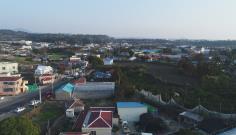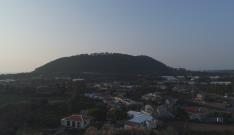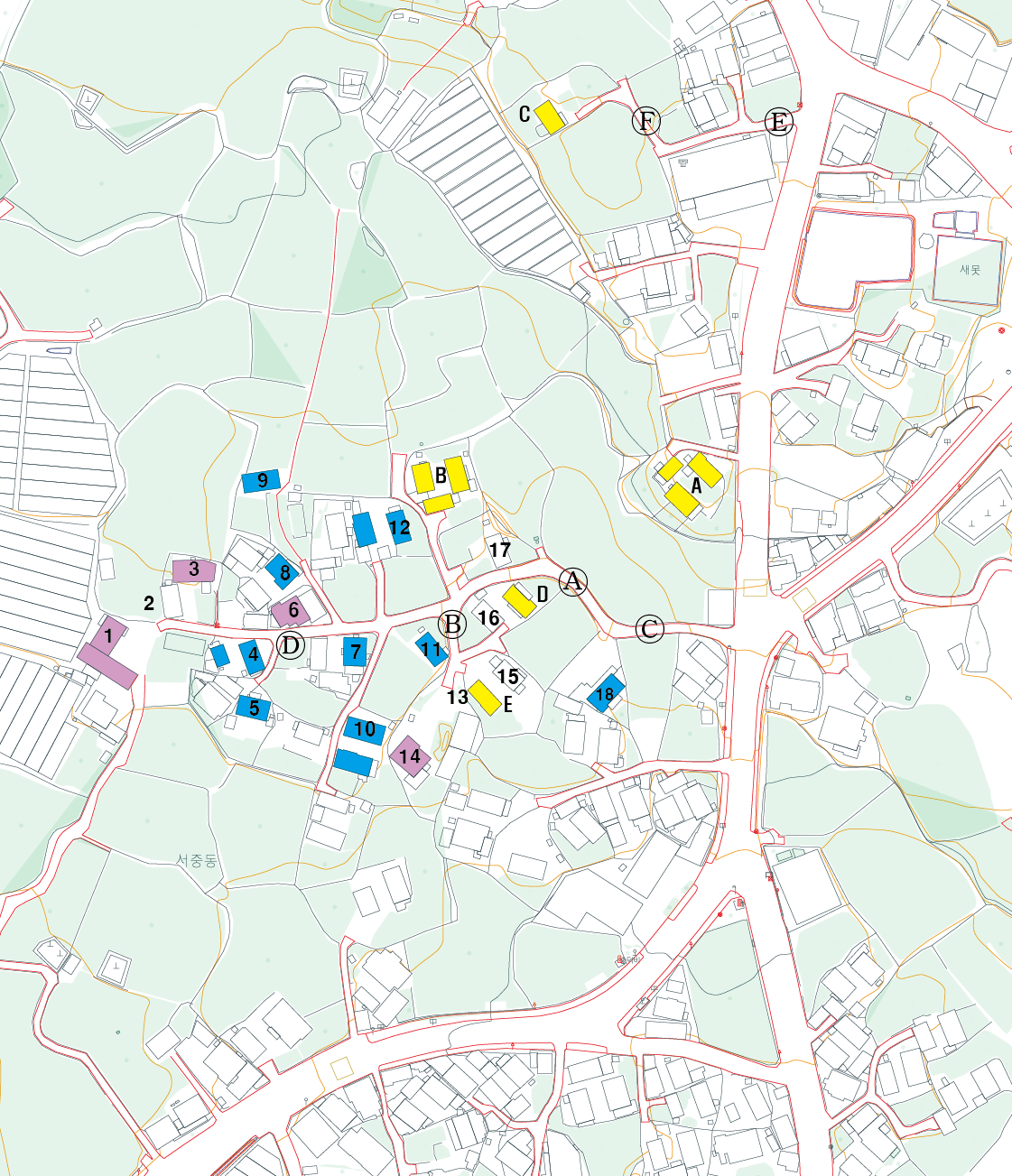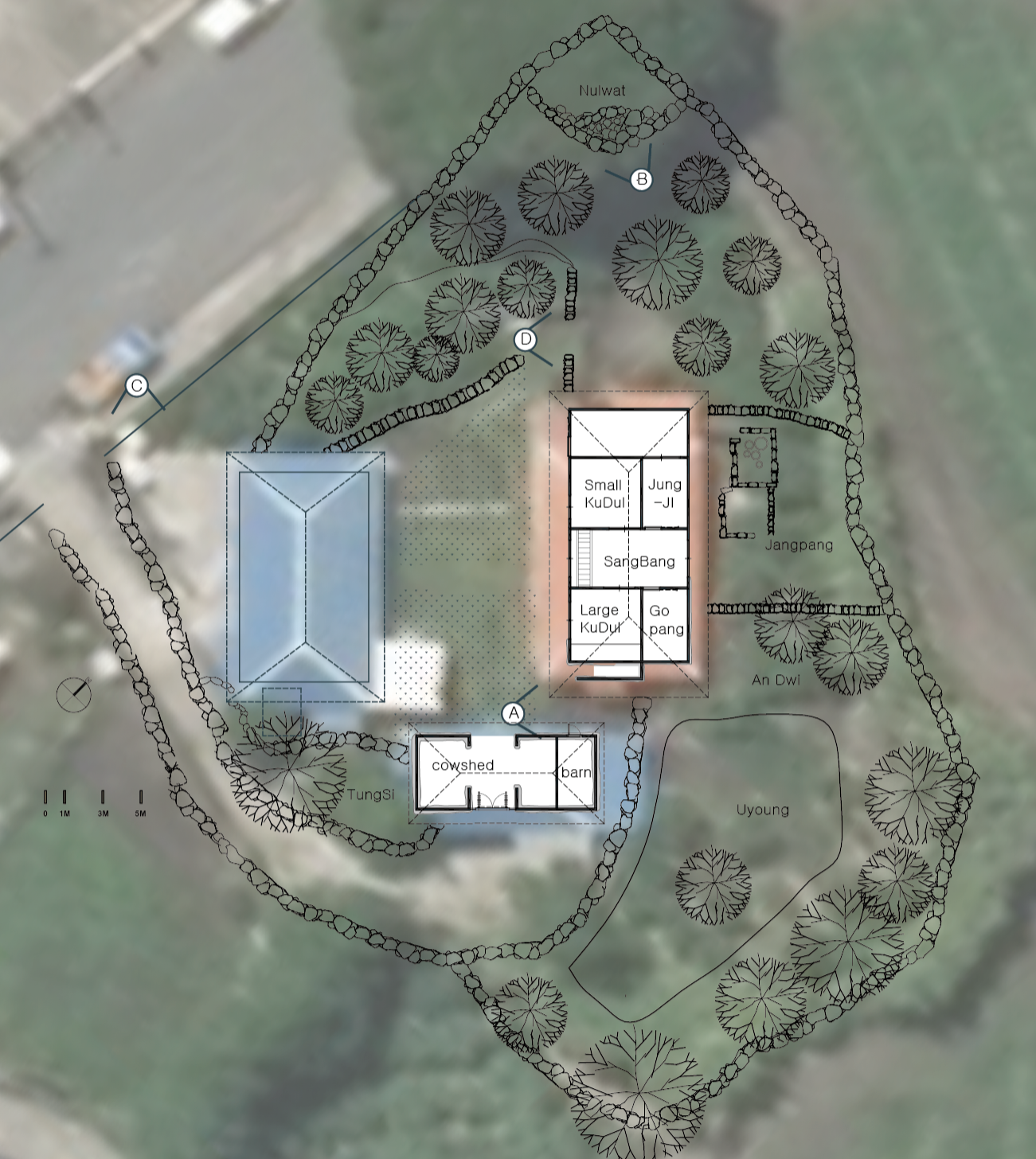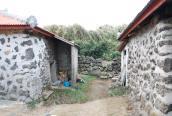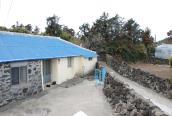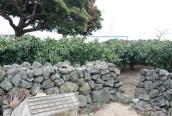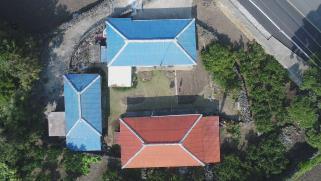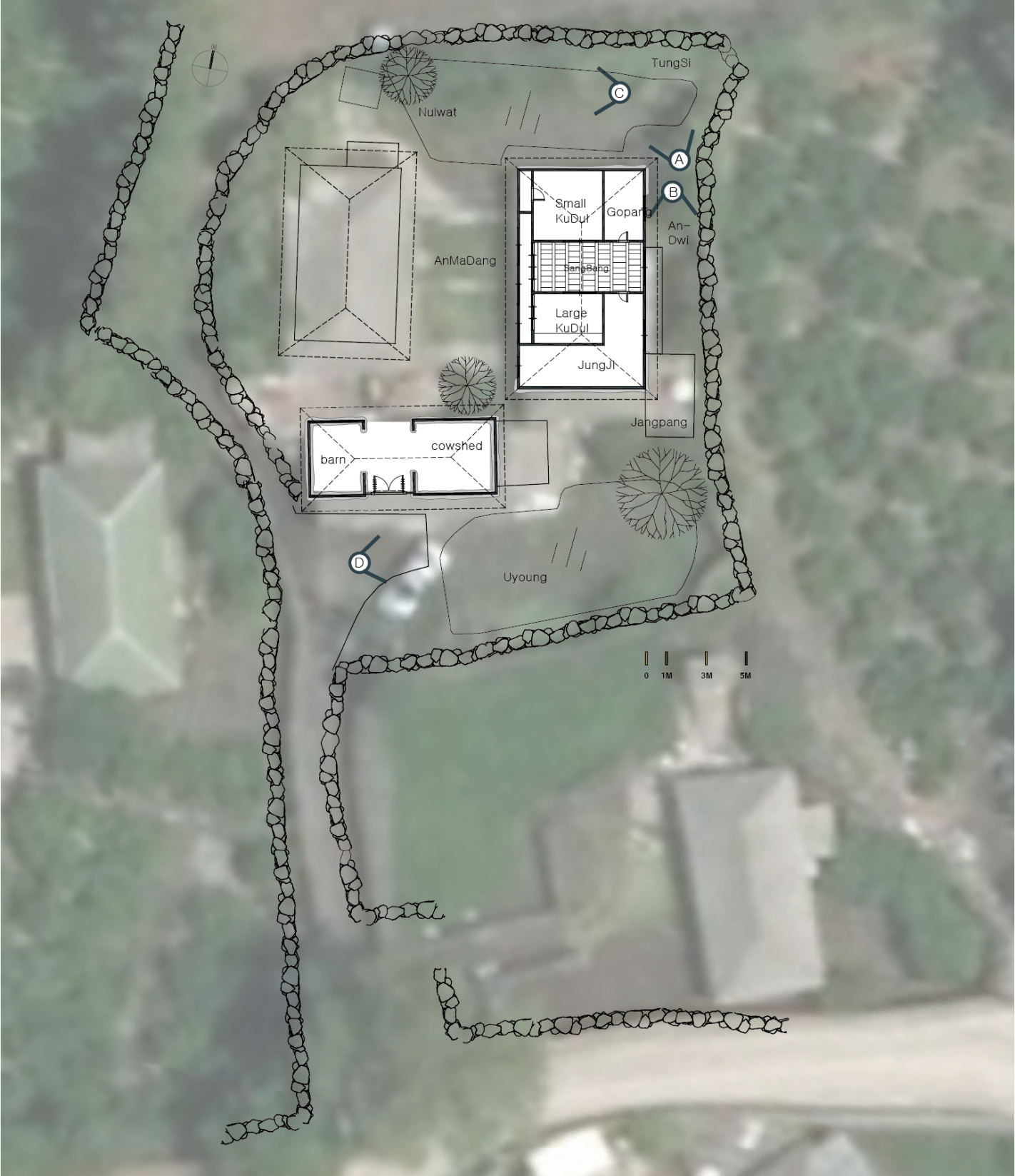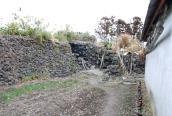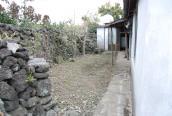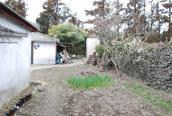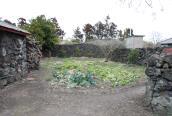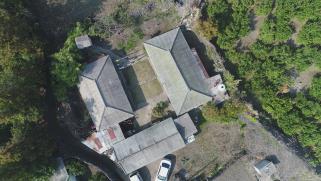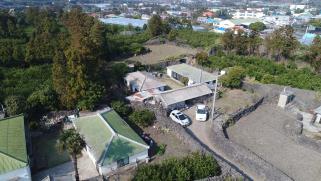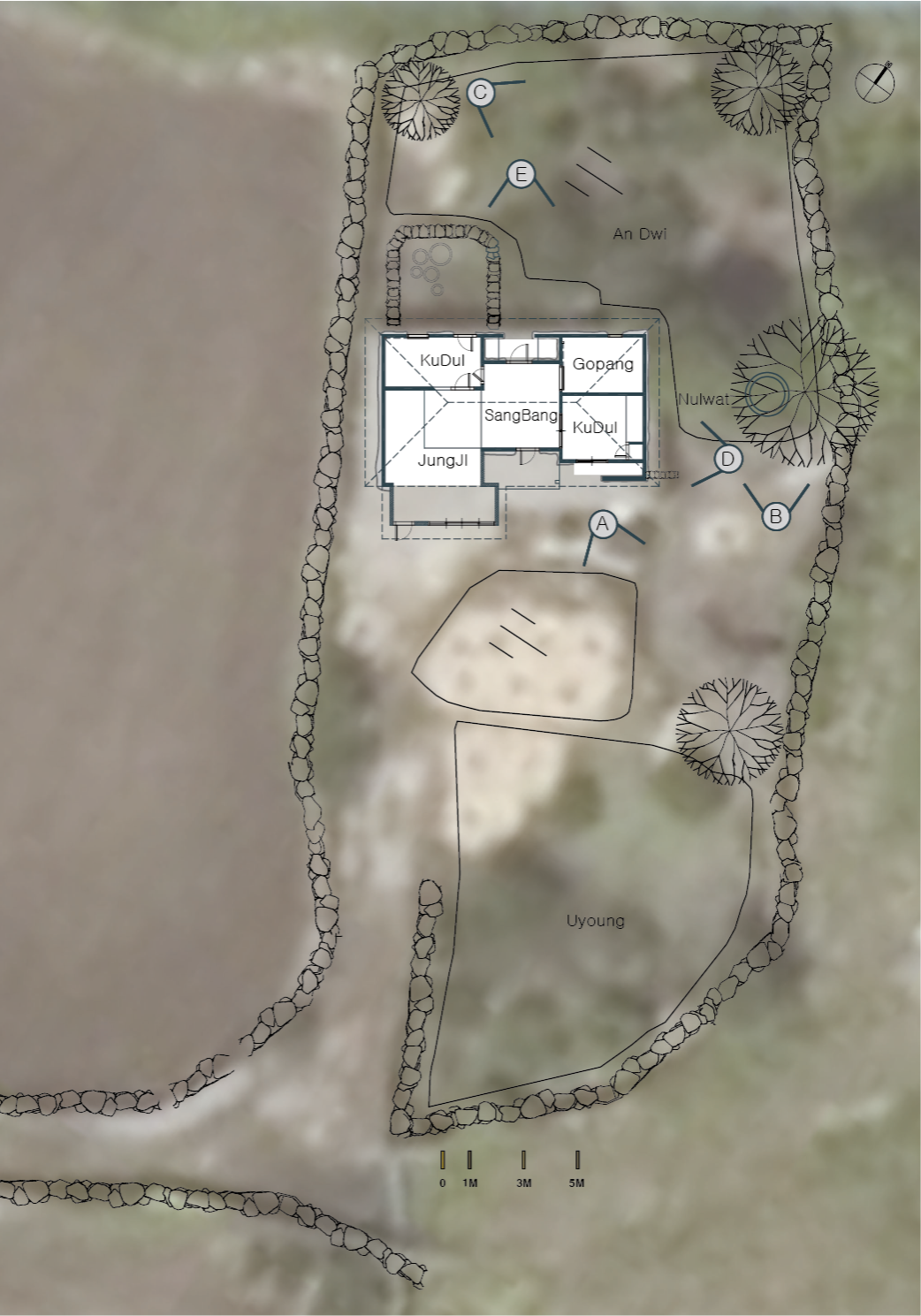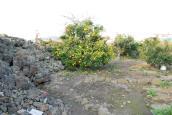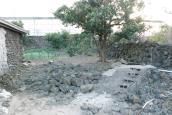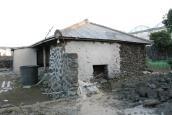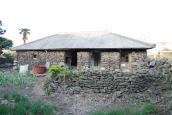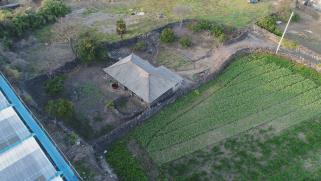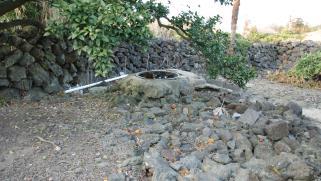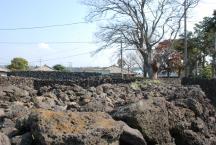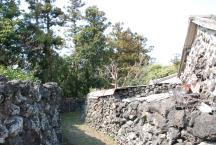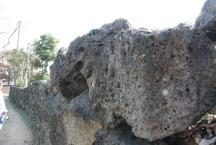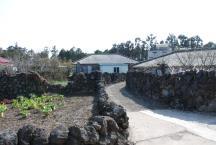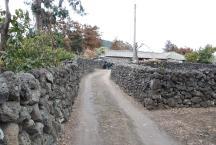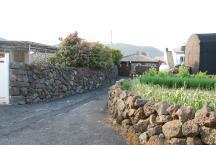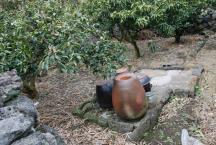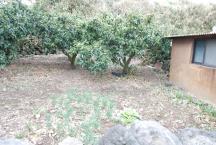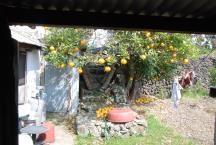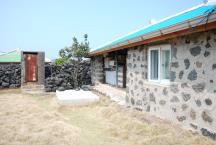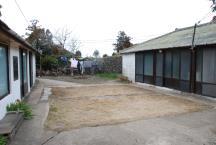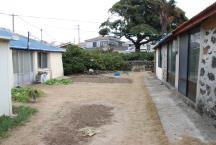
The space composition of the traditional houses in Jeju through ‘Moon jeon bon pu ri’: Focused on the case of the town, Seojung in Napeup-ri, Aeworl-eup, Jeju
@ 2019 KIEAE Journal
Abstract
In the same way as the nature of Jeju island, which is wholly different from the inland area, created unique myth and beliefs, the harsh natural environment of Jeju led to the building of a new type of architecture style that is different from inland area. The layout of housing spaces contain elements related to god, which show their owe toward the element of god. There is a certain settlement of relationship between gods and human beings. Accordingly, this study focuses on the religious mind of Jeju people who had to live a religious life to survive the given environment, and carries out a comparative analysis on the spaces and layout of Jeju traditional houses to discover that they are not only for physical convenience, but there was a consideration with a religious mind of people trying to build an organic relationship between gods and humans in the house spaces. The independent religious mind of Jeju people, which was formed through the historical transmission, will be an important landmark for understanding the awareness system of Jeju people.
This study aims to show the relationship between the space composition of traditional houses and the myth and belief in Jeju based on the cases represented in Napeu-ri, Aeworl-eup, Jeju by analyzing all of cases and interviewing with the residents living on the traditional houses in Jeju. Further, the study includes all of the cases to compare and distinguish other traditional houses and their space composition far from Jeju Island.
First, the main cause is the natural and geographical environment of Jeju island. This can be understood as a result of maximizing the value of the space while securing the living space of the poor islands in which they are located. Second, it is a change of ideas about material poverty in Jeju, which is not rich like inland areas. For each private space, they put clear boundaries and imparted meanings to each space by deifying the places. This reflects the significance and necessity the people felt toward what is called the scarcity.
Keywords:
Jeju mythologyl, Jeju Traditional Houses, Internal·External Space Configuration키워드:
제주 신화, 제주 전통 주거, 내·외부 공간 구성1. Introduction
1.1. The background and purpose of the study
Housing in terms of architecture is not only the most basic and universal subject, but an the important area of human life. To look into the history of housing through human’s private houses means that the structures of house and the space composition of the traditional houses reflect human’s life. In other words, we are not to consider housing or dwelling only as a physical structure any more. It is necessary for us to confirm the historical meaning of traditional architecture and respect its value by looking into ‘Residential Culture’ in the area.
All the traditional housing on the country have got their own distinctive characteristics.
In particular, their lives, which were examined through traditional houses on Jeju Island, follow traditional culture and customs within labor and natural conditions.
This research is meaningful to consider traditional residential space based on myths and beliefs as an attempt to discover and revalue historical materials that have existed only by type.
The study of Jeju's traditional residential space was intended to provide a view into which a series of farming households represented by 'Angeori' and 'Batgeori"1) were interpreted as regional characteristics in Jeju's folklore, beliefs and myths. It is hoped that this unique traditional cultural resources will be used as a core capability of the region to create future value with the aim of exploring and collecting its own sources.
1.2. Methods and ranges of research
As most of the soil on Jeju Island is acidic volcanic ash and is an absolutely unfavorable condition for farming on rice fields, It means that rice field could not be developed due to difficulties to water on the rice field and not enough work force. This characteristic has created the inheritance by equal distribution for the farm land and mixed village.
This system of equal distribution-related inheritance was designed to have both internalism and aortic rites, but to have a sense of community rather than a tradition of mixed villages, it was necessary to establish a common belief system and make new culture, establishing shirine called ‘Bonhyangdang’ to memorate the forefather of each individual family who was firstly settled down on the village.
In Jeju, a village memorial ceremony2) held in the Jeju region until the present day has two ways to celebrate to the gods; ‘Poje’ which is male-centered in a Confucian way and ‘BonhyangdangGuk’ which is female-oriented in Shaman’s way.
In the present study, Napeu-ri, Aeworl-eup is continuing the tradition of Poje, which was designated as an intangible cultural asset, examine the relationship between myths and beliefs through external space that forms traditional residences and the layout characteristics of each space.
Further, the study includes all of the cases to compare and distinguish other traditional houses and their space composition far from Jeju Island.
2. Mythology and architecture in Jeju Island
2.1. The interpretation of housing space through ‘Moonjeonbonpulri“
Jeju Island is a ' mythical island ' and has been rich in stories about 18,000 gods. 360 shrines exist everywhere, and 500 myths have been handed down in the name of ‘Seosamuga’, a ritual dance and lyrics, making it be a top in oral literature. While the Korean Peninsula has strong characteristics of the continent, Jeju has strong ones of the maritime culture through sea exchange, and mythology is no exception.
Mythology and housing space have something in common, considering their metaphors. It means that looking into the story of life, which is accumulated on myths, is like looking at life stories in architectural space[1].
Mankinds basically create their own culture based on their natural environment. Jeju is no exception. Jeju Island has got a unique cultural environment including their own cognition system and housing system due to a lot of factors like closure of the island, adverse living conditions like rain, wind, and poor soil, and the frequent invasion of the Japanese pirates and exploitation of the land from the center for a long time.
Jeju’s poor natural and social environment has created different forms of architecture not found in inland just as Jeju’s environments created myths and beliefs. Those specialties stated above that Jeju has got results from the mechanism to secure its own cultural identity.
There is word like followings; “The residential environment is the most basic for human’s life where people spend a lot of time doing various activities” In regard to the word stated above, it is not reasonable to understand the traditional houses in Jeju in the general meaning of the house, instead, it could be better to understand them in people’s thoughts and religious beliefs in Jeju[2].
There is a distinctive housing culture called ‘Angeori’ which means the inner room and ‘Batgeori’ which means the outer room in Jeju. At the time a son is married, he and his wife live on ‘Batgeori’ while his parents live on ‘Angeori’ But, after a certain period of time, they will switch their room, moving the parents to ‘Batgeori’, and their son to ‘Angeori’ It means that their son starts to have an authority and power of decision in their family. Unlike the inland areas of the Korean Peninsula separating the living space by gender and using the outer room as male space and the inner room as a female space, it is distinctive that the use of the living space in Jeju is divided by the generation and simultaneously it makes them secure their independent space in their houses.
‘Angeori’ and ‘Batgeori’ consist of guest room, hypocaust, storeroom, kitchen and etc. But, ritual ceremonies are held only at ‘Angeori’. For example, the ceremony to commemorate their ancestors are held in guest room and all of the foods for the ceremony are prepared in kitchen. Finally, all of plates and bowls for the ceremony are stored in storeroom.
Meanwhile, it is believed that all of the gods are seated everywhere in the house. Therefore, their religious beliefs have so complex structures in the form and context. Especially, the guest room, kitchen and front yard are considered important thing when the residential space and their religious beliefs are met. All of the gods in the house are specifically described in <Moonjeonbonpulri>[3].
Let me see the case of ‘Moonjeonje’, a representative rite or ceremony conducted by <Moonjeonbonpulri>3).
‘Moonjeonje’ is new year ceremony to wish their family’s good luck. Moonjen means the front of main room’s door. They usually choose the first lunar month for the ceremony. The youngest god called ‘Nodiseongin’ means is a god to guard the family’s safety and luck. Therefore, the god is considered as a supreme god during ‘Moonjeonje’ Its location is on main door to the guest room,
All of the characters presented in <Moonjeonbonpulri> would be family members as well as gods in charge of each area in the residence space. Considering that the gods and the each area of the house are one to one matched <Moonjeon-bonpulri> is specialized to represent the meaning structure which the traditional houses in Jeju and contain the history and contents of the gods dwelling on the houses.
All of the gods in <Moonjeonbonpulri> are the ones in the houses in Jeju. ‘mrs,Yeosan’, one of the gods is on the kitchen and her seven sons are on the center of the guest room while ‘Namseonbi’, a daughter of the god called ‘Noiljedaeguil’ is on the restroom. According to the folk tale, the reason why the ‘Mrs,Yeosan’ and her seven sons are on the room and kitchen is that they are recovering their broken family relationships. But, ‘mr.Nam’ who led to Mrs,Yeosan’s death and broke the family relationship is on the restroom away from the main room. Despite her misdeeds, the structure of confrontation and deprivation is shifting to that of reconciliation and coexistence by taking her as a family member.
2.2. The space composition of traditional houses in Jeju
The fact that Jeju Island's traditional houses differ most clearly from private houses on land is the Centripetal arrangement centered around the yard and complete discrete type of housing. The reasons are attributable to the influence of shamanism and feng shui, in addition to the climate demands and uniqueness of the family system.
In other words, the separate living space[4] in the 'angeori' and 'batgeori' to the unique family system of Jeju Island should be considered as a way to solve the strong weather constraints and to prevent the construction of the area. When it comes to Agriculture and fisheries for a living, the yard is used for drying and working areas of agricultural and marine product and also for preventing the summer's climate condition. On the other hand, when it comes to determining the direction of the 'angeori' many houses take into account ‘feng shui’[5] However, when it comes to determining the direction of the 'angeori' many houses take into account ‘feng shui’ would be considered and the time for building a house is determined by house owner’s date of birth.
In fact, the data collected through the village interview showed that each village had an "Jung-Si"4) or "shaman " a representative town of 'feng shui', and that they had a direct influence on the construction of the site.
The space composition of traditional houses in Jeju Island is arranged in sequence through the courtyard and Wooyoung, which leads to Noolgup and Toongsi. Mr, Byeongchan Go’s House also follows this general pattern of space transfer, particularly in that the outer yard space, which is comprised of embracing the An geori and Bak geori, is a unique blend of its own independent areas, unlike the normative spatial composition of interior spaces.
The fact that Jeju Island's housing is given divinity for each element of space is a living truth figure, as a living entity, the house represents the symbolic meaning of living with people. Despite of this fact, the space for the commemorate their ancestors does not create a space to keep an ancestral tablet in their houses except for ‘Batchilsung’.
It is understood that 12 gods live together on the house and take charge of all of the things related to the house and family. It means that they structuralize the inner space of the house and they are ranked through the physical formation of the outer space of the house.
2.3. The residential environment and the spread of population in Jeju
Jeju Island is divided by two parts; Jeju City, northern area and Seoguipo City, southern area by Mt Halla. Aeworl-eup is a town in the western part of Jeju City. It is bordered by Nohyeong-dong and Oeingi-dong in the east, Hallim-eup in the west, Mt. Halla in the south, and the sea in the north. Northern and southern of Jeju Island also differ greatly in terms of population composition, especially when looking at the distribution of elderly population.
The method of data collection through interviews with the old is not only a very traditional and indispensable method of research to secure high confidence, but it is also a circumstantial evidence that a favorable residential environment has been formed for a long time.
In regard to the population of the an aged, the distribution rate of the an aged in northern part of Mt. Halla is high while in southern part, the one in eastern part is higher than that in western part(data of Statistics Korea).
This phenomenon can be interpreted as a result of regional development, such as the transfer of residential areas by urban development, the one hand, in-depth discussions are needed in terms of the psychological condition of family members on the need to change the traditional values that make up the housing space and improve the physical conditions of the housing environment.
3. Research Subjects and Its Analysis
3.1. Selecting a site for research
The study of traditional houses is believed to have been concentrated on the study of statistics on a wide range of statistics and interpretations of a particular space in a system established by the scholars who was educated under Japanese rule. However, from the early 1980s, a study of general characteristics, such as the location, spatial composition, and floor plan type, was mainly conducted. The characteristics of spatial structure changed to regional, religious, and ecological environments after the 1990s. Recently, because geographical research and interest in the values of the traditional houses are increased, the reservation and use for the traditional houses have been widely discussed.
Napeup-ri, a small town in Aeworl-eup which is located on the North-west area in Jeju has been famous for a place of scholars and has produced outstanding talents during Chosun Dynasty. So, all of the folk beliefs and ceremony in this village has a strong characteristic related to Confucian. Especially, ‘Poje’, a ceremony to wish people’s good luck in the village is one of the examples to represent the characteristic of Confucian and it has been preserved well.
All of the rituals or ceremony in Napeup-ri where the Confucian has got a dominance have held in Confucian way and any ritual or ceremony related to Shamanism has not been found.
All of the rituals or ceremony in Napeup-ri where the Confucian has got a dominance have held in Confucian way. it is designated as an intangible cultural property of Jeju Island to protect it as a specimen because it is typical of the Confucian village of Jeju Island.
The origin of the word, ‘Napeup’ is from the meaning that all of the people have come together due to its natural environment. It stretches along the border of ‘Hallimcheon’, a stream into the south-east area of Mt Halla and is largely divided by two parts; east and west and according to the geographical features, it is divided in three parts: Upper, Mid and Down. Therefore, the name of Upper-east, Mid-east, Down-east, Upper-west and etc exist in the Napeup-ri.
Napeup-ri is a filial and longevity village, and as it was easy for the elderly to meet their residents on the traditional culture and history of the region. Especially, Mid- west is required to be researched throughly because it has a lot of the genuine traditional houses through the interview and research with the people in the town.
3.2. Analyzing the Characteristics of traditional housing in jeju island
His house is the oldest in the town and consists of Angeori, Batgeori and Mogeori. Angeori is living space for his mother and Batgeori is for him and his wife. The date of the construction was recorded as 1948 when the house was first investigated, but Ko Byung-chan said it had been purchased and moved in 1948, suggesting that it was far earlier.
Many of the major parts, including walls and roofs, have been repaired over the decades, but since there have been no acts such as transformation or reconstruction of the structural department, a considerable portion has been preserved as a prototype.
About the An Dwi. Go's mother said that when a family member is sick or undergo an ordeal, acts of prayer were usually performed around the kitchen or backside.
‘Moolpang(Jeju dialect of a stone shelf resting on a water jar)’5), a big jar to store water which his mother has used is located on the front yard and it would have a special connection with kitchen and An Dwi.
Since ancient times, Jeju Island has been an area where drinking water is scarce, so it was considered a big event for women in the neighborhood to work together for bring in water from their home with a big jar. Given these circumstances, a symbolic meaning of ‘Moolpang’ is not only seen as a convenience device, but also as a medium to bring them a good luck. Go Byung-chan's house is comparatively sizable and has a specialized composition in Angeori. The structure behind the view is very phased and hierarchical, such as Wooyoung's territory, which is also distinguished in 'an dwi' and 'U yeoung', which is most secretly formed.
Kim Hee-ik is 90 years old, also bought a house in the village in a similar relationship with Go byeong-chan’s house.
The two houses were confirmed to have similar construction dates, but neither was the exact date.
Kim Hee-ik, the current owner of the house, lives in Angari with his son and son’s family. Due to the short distance between the east and the west, and the long north and south, the area of the DwiAn is insufficient to form a Uyeong.
While remodeling the Angeori, the building of the modern bathroom was built in the backyard and Jangdokdae was placed on the roof.
In addition to the side of the courtyard, Uyeong was placed outside the corner of Mogeori's door and used to use Tungsi, which used to be located at the end of the courtyard, as an incinerator.
‘Moonjeonshin’, a god of door is considered as the most important god and it is natural that it is treated best among the gods living on the house.
In addition, whenever spring begins, he thinks that it would be a guardian to protect him and his family from the evil spirits. His son and daughter in law testified that they had put an amulet on the main gate and burnt some of paper tablets on the back yard after sacrificing to their ancestors.
Kim's house, due to the characteristics of the type of land, Uyeong’ a large area outside the street. Rather, walking past the gate and into the courtyard will increase the concentration of interior space, thereby raising the sense of space that is more dense.
The house above is the house of Kang Tae-bum's grandmother, and nobody lives after she dies. The house on the knoll outside the village had a long stretch of Olle Road.
The house is a One-Geori house with only angeori, with the shape of the wall of the tent, the original shape of the old and antique rooms, except for the expansion of the front section towards the courtyard.
It is a very important feed that can be inferred about the size and type of traditional houses in this area. Particularly, a well is located close to ‘Nulgup’ which is also adjacent to the exposed ‘Gulmok’ It is distinctive for the house to have ‘Jangpang’ which is made of Angeori’s small hypocaust and ‘Batdam(farm’s stone wall)’, a low wall toward the farmland. The Batdam around ‘Jangpang’ would be designed to protect the food from the birds and wild animals as well as to define a boundary. Considering the height and shape of the Batdam, it is assumed that the device was designed to distinguish areas.
It is also interesting to note that ‘Jangpang’ is only designed to enter and enter through a ‘GolBang(small room)’.
The composition of Angeori’s inner wall is like the followings; window, door and ‘Changkum(Jeju dialect means which is small window)'.
They have their own distinctive role. In addition, the inner side wall and rear wall has ‘Jeongjedeetmoon’ and ‘Netgomang’ and the original form of ‘Changkum’ is found between ‘Gopang’ and back yard.
3.3. Residential Space of mythical thinking system
The traditional houses of Jeju Island are characterized by the concentration of all the elements that make up the living space within the fence.
The fence in a Jeju traditional houses, or Wooldam, protects the interior of the dwelling from the outside space and protects the house from the danger of collapse in the event of strong winds. It also symbolizes a direct link between ‘Jangpang’, ‘Uyoung’ and ‘Nulwat’.
Wooldam forms a boundary from the outside with a courtyard and a back garden, an outside street backyard, Uyoung, Nongwang, Jangpang, and Tongchi.
Olle is an external buffer zone that replaces the gate and blocks the entry of unclean things.
The stone walls of the village are shaped in different shapes depending on the length and width of the olle and the relationship with the surrounding house(refer to Table 4.).
Through the interview with the residents about Olle, they have thought it as another trail in their own houses. This means that Olle is a part to consist of their own houses.
In case that Wool dam was damaged, unless they do their best to fix it, it would provoke the god of land and another bad luck or disaster would come to the residents6). In other words, when they fix it, they have to do their best and be cautious.
An dwi, which stands for An geo ri's backyard, placed " Jang Pang " and " Tong si " on the corner because the wind, if blown directly against the stone wall, could be damaged by concentrated wind pressure. And it is assumed that normative customs were used to form rational circulation when the placement of Uyoung.
Through the interview with the residents, Andwi is considered as a place to pray for their family’s good luck as well as one for women.
In particular, Jang pang's location, which stores soy-sauce, is located in the backyard from a Sang Bang(small room). The location of this Jang pang is in stark contrast to the location of ‘Jang dok dae’ in other areas, close to the kitchen.
‘Jang pang dee(jar)’ where ‘Jang pang’ is located is only place for the women like ‘Go pang’. As like stated above, ‘Jangpang’ in Mr, Gang’s house has a distinctive closure because it is place only for women. Especially, ‘Jang pang Dwi’ and ‘An Dwi’ are identified as same space in terms of considering them as a holy place which ‘Chil seong nul’ and ‘Bat chil sung’ dwell on.
In addition, ‘Woo young’ which is separated from ‘An dee’ is not only farmland to grow vegetables and fruits for their sacrifice to their ancestors and plant some of ike trees like mandarine, bamboo, persimmon tree and etc, but is used as a storage for them.
It is a kind of place to store all kinds of crops and fruits for their diet. There are a lot of big jars according to their use in Go pang while it is also a place sacred to ‘An chil sung’, one of the gods to dwell on the house, as well as a place only for women.
In the past, all of the women in the village had to perform a rite for ‘Anchilsung’ and considered another god called ‘Goipang- halmang’ as an important divine to protect crops, vegetables and fruits as much as ‘Jowang-halmang’.
In addition, there is a pillar called ‘Saengi-column’ or ’Baegi-column’(buried the bottom of the pillar in the ground) between ‘Gopang’ and mainroom which is a place for the eldest in family to make an important decision.
Many of the village's grandmothers reported that the god of the village, who was seated in Goepang, was believed to be an important person in charge of the protection of food and food.
The front of the traditional house toward the front yard has another space called ‘Moot deung’ or ‘Nang gan’ from outer wall in order to buffer strong impact from the outside. Especially, the space is connected to the floor of Sangbang and plays a role to divide yard from room.
Sangbang is located between Kudul and ‘Jeongji’ or between Kudul. Its size is around 6.6mand specialized and multi-purposed place to sleep, perform a sacrifice for their ancestors, have a meal, treat guests and etc.
As for the entire residential area, Sangbang plays an role, taking away unnecessary moving line as the central area of the interior space. From this reason, it would not be strange that the front window facing the front yard is called the gate, and even ‘Moodeung’ is interpreted as the meaning of ‘Bongdang ’ on land.
One characteristic of Sangbang has a back door and is used as a living room as well as sleeping room during summer.
When the construction for the house begins, a ritual ceremony called ‘Gut’7) to pray for the safety is held. At this moment, a kind of amulet called ‘Jiboo(A world in which the soul goes and lives after a man dies)zzim’ dampened with liquor is attached to the wall. Like this, the people in the village have considered the ‘Moojeon’, one of the gods to live on the house as an important divine, represented in their proverbs as like “ There is no ritual ceremony without ‘Moojeon’ like there is no a guest without a host.”
Angeori’s Nangan in Mr Go, Byeung-chan’s house burned down, but the frame of the door still exists. The wood floor of Sangbang is replaced to the papered floor.
According to Munjeon Bonpuree, Sangbang, the most important place of house, is the center that sets the boundaries of spaces in Jeju folk houses. But Sangbang breaks down the boundaries of one-to-one corresponding structure between spaces of Jeju folk houses and the household gods. Then, finally, it transformed the house into a field of harmony and unity where there are no blockage. It made a field where the spaces of Jeju folk houses and the household gods can communicate freely. Sangbang is the first entrance to the folk house and, at the same time, it is the center that establishes strict boundaries for each space of each private house.
Examples of setting strict boundaries for space are the case of Sangbang and kitchen. As to the relationship between Sangbang and kitchen, the kitchen is understood to be a space corresponding to Sangbang in that it was taken care of by women. And it sets the meaning of the two spaces as the relationship between Munjeonshin(god of front door) and Jowangshin(god of kitchen), just like the relationship between a man and a woman, and translates them as the spatial characteristic of Jeju traditional houses.
The wall of the traditional houses consists of three layers; ‘Simbyeok’, a clay inner wall of the house, ‘MainWall’, a stone outer wall of the house and ‘Wooldam’, a stone fence along ‘Olle’. Simbyeok and Joobyeok surrounds the inner space of the houses while ‘Wooldam’ surrounds the outer space of the houses.
As a result, the people in the village have called the front yard as ‘DdeulBang(A room in courtyard)’, a concept of one room by expanding the meaning of front yard to one of the room where people live.
The ground of the front yard has a multitude of function. People usually dry their crops on the ground because it blocks moisture from the land. Sometimes they put some of the chaff on the ground during rainy day in order for the convenience in walking as well as to block wind-blown dust in the air. When the chaff is worn off, the chaff residue is used as a fuel for their lives.
Anmadang is another space to make a communication and for harmony through connecting the inner space with the outer space of the house when they hold a ritual ceremony for their family’s good luck.
The restroom is called ‘Tongsi’8)[10] in Jeju which is located in the living space of the house. In specific, it is beside the side of the inner room; the living space and the restroom are located so close.
There are only a few cases to confirm Tongsi’s original form in Jeju's traditional villages and it is hard to identify their previous locations.
In regard to this, Mr Go Byeoung-chan’s house is a rare case to have Tongsi’s original form and it had been actually used as a restroom until 1980s. Although they do not use it any more after installing new 'water closet' beside Tongsi, they still consider it important and that it has a great symbolism to the family members.
This characteristic for Tongsi is seen in Napeup-ri as well as every house spread in Jeju. Even now, it could be used as public restroom somewhere in Jeju9).
At first, it was a space to process people’s excreta to pig’s feed unlike that on land. After that, its use was expanded to make a fertilizer for crops, especially important to barley farming. In particular, they tried to plant shade trees next to the Tongsi to prevent heat in summer and put some of the chaff on the hole of the wall to keep their pigs warm in winter in pig farming because they thought that pig had more values in their meat self-sufficiency and household income.
The reason why Tongsi is closely to the room was that it did not have odor, putting all of the chaff and seaweed on the excreta to decompose it completely and people did not feel any reason why Tongsi was far away from the room.
This, in turn, was deemed to have been closely related to the ' safety zone ' and ' outside street ' in consideration of the shortening and efficiency of living circulation. However, it is recommended that Tongsi should be a little far from the room according to <Moonjeonbonpulri> because a ‘Tongti’, had hidden dangers. Probably, it means that people have a caution for their health in sanitation and hygiene not to have a disease.
4. Conclusion
In the same way as the nature of Jeju island, which is wholly different from the inland area, created unique myth and beliefs, the harsh natural environment of Jeju led to the building of a new type of architecture style that is different from inland area. The low roof and stonewall were designed to overcome poor conditions such as rain, wind, sunlight, and Pungche was made to control light at their best.
At the same time, I thought that the sense of the divine mystery and awe were inherent in the way in which the layout of the dwelling was organized.
Not only is the spatial arrangement of traditional Jeju folk houses a physical device to overcome natural environmental limitations, but there is also a religious nature for the formation of organic relationships between gods and humans through residential space.
These efforts of Jeju people reflect their precise observation and wisdom based on science. Concurrently, the layout of housing spaces contain elements related to god, which show their owe toward the element of god.
Accordingly, this study focuses on the comparative analysis on the spaces and layout of Jeju traditional houses to discover that they are not only for physical convenience, but there was a consideration with a religious mind of people trying to build an organic relationship between gods and humans in the house spaces.
In <Moonjeonbonpulri>, Jeju people try to give meanings to the rooms of folk houses by defining clear boundaries of the space layout and setting each of their purposes. Each room was deified to elevate the meaning of ordinary private houses to sacred places. Each room is set up in a corresponding position with each of the house gods.
For this, there are two reasons to understand:
First, the main cause is the natural and geographical environment of Jeju island. This can be understood as a result of maximizing the value of the space while securing the living space of the poor islands in which they are located.
Second, it is a change of ideas about material poverty in Jeju, which is not rich like inland areas. For each private space, they put clear boundaries and imparted meanings to each space by deifying the places. This reflects the significance and necessity the people felt toward what is called the scarcity. However, each of the space of the traditional houses are explained as the followings, based on all of the cases collected and <Moonjeonbonpulri>.
First, ‘Olle’, ‘Dwian’, ‘Anmadang’ and ‘Tongsi’ as a representative consisting of the outer space of the traditional houses in Jeju have differences in a way where they are formed, but have a common function to set a boundary between in and out and simultaneously connect them. ‘Tongsi’ would be like an alienated and highly regarded space, but it would also play a same role like three others.
Second, ‘Sangbang’ and ‘Gopang’ as a representative comprising the inner space of the traditional houses are so practical and symbolic. The former which has a variety of function would be a little different from the latter which has only a function, but they are not only in charge of the family’s luck, but also are a space for the harmony and coexistence.
Jeju's architecture is the result of the cultural, historical, and thought of the time combined with the natural environment. It is also a product made to meet functional demands and at the same time is given religious symbolism.
In this sense, traditional Jeju houses are involved in the mental and unconscious parts of Jeju residents. Thus, there is a religious nature for the formation of an organic relationship between humans and gods.
Furthermore, I hope that Jeju's traditional housing and myths will be used as a basis for analyzing the housing culture of East Asia Island in the future.
Acknowledgments
This work was supported by the Ministry of Education of the Republic of Korea and the National Research Foundation of Korea(NRF-2017S1A5A2A03068766).
Notes
References
-
양성필, 신화와 건축공간, 한국, 생각나눔, (2012), p9.
Yang, Seong-phil, Myth and Architecture space, Korea, Think-book, (2012), p9. -
김영주, 제주전통민가의 공간배치를 통해 본 제주도민의 종교심에 관한 연구, 한중인문학회, 53, (2016), p34-35.
Kim, Yeong-joo, (2016), A study on the Citizens of Jeju Island on Religious Mind through the Space Arrangement of the Traditional Houses in Jeju, Studies of Korean & Chinese Humanities, The Society of Korean & Chinese Humanities, 53, (2016), p34-35. -
현용준, 제주도 무속과 그 주변, 한국, 집문당, (2002), p260-261.
Hyeon, Yong-Jun, Jeju Island Shamanism and the Surroundings, Korea, Jipmundang, (2002), p260-261. -
박은영, 19세기 제주도 민가의 공간구성 변화에 관한 연구, 한국, 홍익대학교, 석사학위논문, (1999).
Park, Eun-young, Research for the change in the space composition of Jeju’s traditional houses in the 19thcentury, Korea, Hongik University, masters degree, (1999). -
송성대, 제주도의 風土住家 : 草屋民家를 중심으로 하여, 제주도연구회, 10, (1993), p111.
Song, Seong-Dae, Vernacular Houses in Cheju Island, Society for Cheju Studies, Journal of Cheju Studies, 10, (1993), p111.
